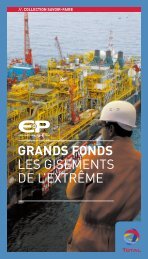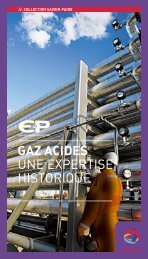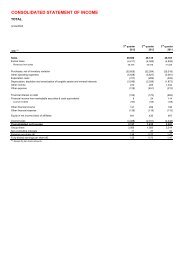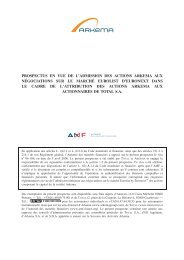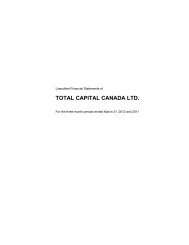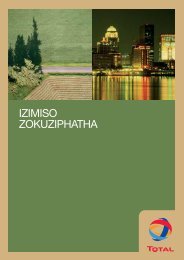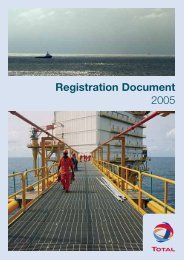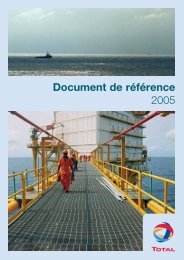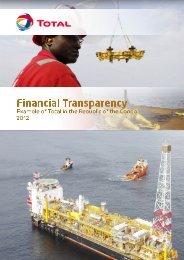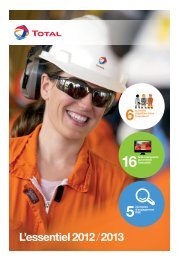Registration document 2007 - Total.com
Registration document 2007 - Total.com
Registration document 2007 - Total.com
You also want an ePaper? Increase the reach of your titles
YUMPU automatically turns print PDFs into web optimized ePapers that Google loves.
10<br />
The following tables present, for crude oil, condensates and<br />
natural gas liquids reserves and for the natural gas reserves, an<br />
estimate of the Group’s oil and gas quantities by geographical<br />
areas at December 31, 2006, 2005 and 2004.<br />
Quantities shown concern:<br />
• proved developed and undeveloped reserves together with<br />
changes in quantities for 2006, 2005 and 2004;<br />
• proved developed reserves.<br />
The definitions used for proved oil and gas reserves, proved<br />
developed oil and gas reserves and proved undeveloped<br />
reserves are in accordance with the applicable U.S. Securities<br />
and Exchange Commission regulation, Rule 4-10 of Regulation<br />
S-X.<br />
Proved reserves are estimated using geological and engineering<br />
data to determine with reasonable certainty whether the crude oil<br />
or natural gas in known reservoirs is recoverable under existing<br />
economic and operating conditions.<br />
This process involves making subjective judgments;<br />
consequently, estimates of reserves are not exact measurements<br />
and are subject to revision.<br />
The estimation of proved reserves is controlled by the Group<br />
through established validation guidelines. Reserve evaluations are<br />
made annually by senior level geoscience and engineering<br />
professionals (assisted by a central reserves group with<br />
significant technical experience) including reviews with and<br />
validation by senior management.<br />
Significant features of the reserves estimation process include:<br />
• internal peer-reviews of technical evaluations also ensuring<br />
that the SEC definitions and guidance are followed; and<br />
• a requirement that management make significant funding<br />
<strong>com</strong>mitments toward the development of the reserves prior to<br />
booking.<br />
All references in the following tables to reserves or production are<br />
to the entire Group’s consolidated share of such reserves or<br />
production. TOTAL’s worldwide proved reserves include the<br />
proved reserves of its consolidated subsidiaries as well as its<br />
proportionate share of the proved reserves of equity affiliates and<br />
of two <strong>com</strong>panies accounted for by the cost method.<br />
The reserve estimates shown below do not include quantities<br />
that may or may not be produced, due to changes in economic<br />
conditions or pursuant to new technologies.<br />
238<br />
Appendix 2 – Supplemental oil and gas information (unaudited)<br />
Oil and gas reserves<br />
Oil and gas reserves<br />
TOTAL – <strong>Registration</strong> Document 2006<br />
Rule 4-10 of Regulation S-X requires the use of the year-end<br />
price, as well as existing operating conditions, to determine<br />
reserve quantities. Reserves at year-end 2005 have been<br />
determined based on the Brent price on December 31, 2006<br />
($58.93/b).<br />
Proved reserves are the estimated quantities of TOTAL’s<br />
entitlement under concession contracts, production sharing<br />
agreements or buy back agreements. These estimated quantities<br />
may vary depending on oil and gas price.<br />
An increase in year-end price has the effect of reducing proved<br />
reserves associated with production sharing or buyback<br />
agreements (which represent approximately 30% of TOTAL’s<br />
reserves as of December 31, 2006). Under such contracts,<br />
TOTAL is entitled to receive a portion of the production,<br />
calculated so that its sale should cover expenses incurred by the<br />
Group. With higher oil prices, the volume of entitlement<br />
necessary to cover the same amount of expenses is lower.<br />
This reduction is partially offset by an extension of the duration<br />
over which fields can be produced economically. However, the<br />
increase in reserves due to the extensions is smaller than the<br />
decrease in reserves under production sharing or buyback<br />
agreements. For this reason, a higher year-end price translates,<br />
on the whole, into a decrease in TOTAL’s reserves.<br />
The percentage of proved developed reserves has remained<br />
relatively stable over the past five years, indicating that proved<br />
reserves are consistently moved from undeveloped to developed<br />
status. Over time, undeveloped reserves will be reclassified to the<br />
developed category as new wells are drilled and/or facilities to<br />
produce from existing and future wells are installed. Major<br />
development projects typically take two to four years from the<br />
time of recording proved reserves to the start of production from<br />
these reserves.




